Menus
- Dreams of big children
- 4-stroke single cylinder, 125 cm3, 15 hp and 11.7 Nm, 146 kg full made, from 4,599 euros
- Discovery
- In the saddle
- In the city
- Motorway and expressways
- Departmental
- Gymkhana and track
- Part-cycle
- Braking
- Comfort / Duo
- Consumption
- Conclusion
Dreams of big children
4-stroke single cylinder, 125 cm3, 15 hp and 11.7 Nm, 146 kg full made, from 4,599 euros
The 125 cm3 motorcycle segment is an important market, largely represented by brands … except Kawasaki …. or at least not with a recent and attractive machine. His D’tracker and KLX released in 2011 were no longer on the agenda. And only a J125 scooter remained available. In this sector on the rise, the manufacturer of Akashi had to react.
And these are two machines that the green firm offers us for testing. A nasty roadster, the Z125, rubs shoulders with a sharp sports car, the Ninja 125. Aimed at holders of the A1 motorcycle license, they offer young bikers the opportunity to access a light and compact sports car. Built in Indonesia, these "Kawettes" are inspired by their glorious and superior elders Z650, Z900 and ZX10…. It is in Malaga, Spain, that we study their parentage, on the heights of the Iberian coast..
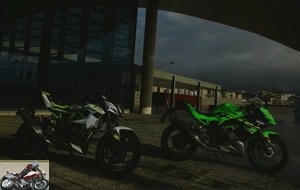
Discovery
They have a good face! Especially the Z125, taking again the style "Sugomi" dear to Kawasaki, declining its sharp codes on all its roadsters. The little one mimics the big ones, playing shoulders with its large scoops and its diamond optic framed by deflectors. As an extension of its angular 11-liter tank, a rather attractive pilot seat, coupled with a passenger seat that is already less engaging. The saddles dominate a tapered rear loop with marked angles, rising towards the heavens. They conclude with a soaring LED brake light dominating a minimalist license plate holder. What style ….
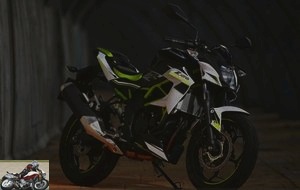
The Pocket Ninja is a little less ostentatious, more or less taking over the lines of the SBK champion. Its dress all in taut lines dresses in fact, more widely on the front, a base almost identical to that of the Z.
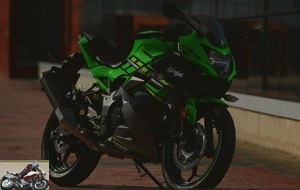
Techno-aesthetic variation requires, a tubular frame supports the machines, as on the H2, H2 SX, Z650 and Z900…. It is here made of steel and encloses the single cylinder of 125 cm3.
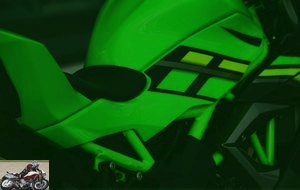
The block is fitted with four valves actuated by two camshafts and has a super square bore-to-stroke ratio of 58.0 x 47.2 mm. The mechanics develop 15 hp (11.0 kW) at 10,000 rpm and 11.7 Nm at 7,700 min. It is also calibrated to give the most approval below 100 km / h and is based on a 6-speed gearbox..
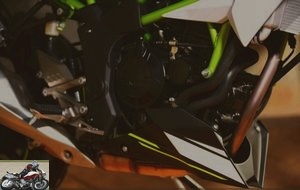
There is a slightly different geometry between the two Kawettes: the Ninja’s hunting angle is 23.8 °, that of the Z tightens with 23.1 °, but the wheelbase remains the same, 1.330 mm. Values giving more agility to the roadster.
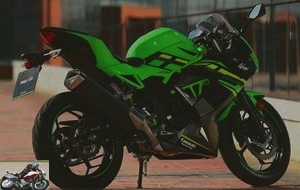
A 37 mm telescopic fork and a Uni Trak type mono-shock absorber mounted on rods make up the machine suspensions and their 110 mm travel. They have slightly different settings to suit the profile of their segment. Only the rear element is provided with a preload adjustment to manage the movements of a fairly common rectangular section steel swingarm. More enjoyable, the 17-inch split-spoke 10-spoke rims provide good aesthetic dynamics, reinforced by green edging. They fit new Dunlop TT900 sport-road type tires.
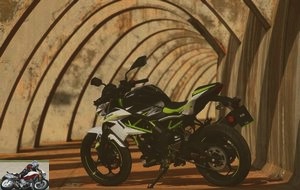
To slow the little ones down, a twin-piston caliper bites a 290mm petal disc up front. Identical, the opposite clamp grips a 220mm wafer, ABS included.
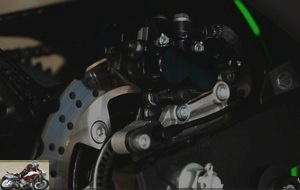
Engine housings with neat surfaces and arrangement of the elements ensure a good presentation to the Kawasaki 125. The rider and passenger footrests, rubber-coated on the Z, are attached on both 125s to aluminum support plates. However, we regret the cooling circuit hoses that are too present, a somewhat "tinkered" radiator mounting bracket and a fairly common engine finish, without an inverted fork or radial brake caliper that can be found on the Yamaha YZF-R125 . Finally the Kawasaki Ninja 125 and Z125 admit respectively 148 kg and 146 kg.
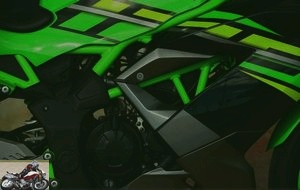
In the saddle
Of course very similar in construction, the two small Kawa stand out in ergonomics on several points. The driving position is therefore straighter on the Z125, which is fitted with a flat handlebar. It also benefits from an upper saddle height of 30mm, peaking at 815 units. Very pleasant for older children to accommodate their leg, with the bust however noticeably leaning forward. Clamped between its saddles and the pretty plate signed on the upper crown, the hanger raised and pulled back towards the rear gives a comfortable position.
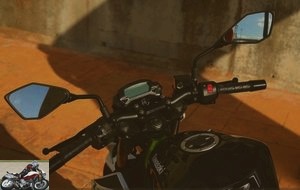
The sport is therefore surprisingly lower at 785 mm and accommodates the hands on the handlebars bracelets. It causes sport! Thus tilted forward, we notice an openwork molded upper tee.
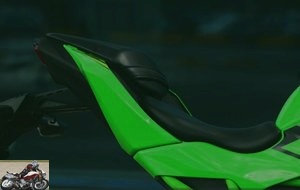
Without being models of comfort, the seats are made of quality foams. In addition, my eighty-four meter is in no way cramped on board, whatever the machine.
A compact and somewhat cramped digital instrumentation includes bar-graph type tachometer, tachometer, two partial trips, an odometer, clock and fuel gauge. Finally, if the instrumentation on the 125 is identical, an amber light illuminates that of the roadster…. like on an old Z1000.
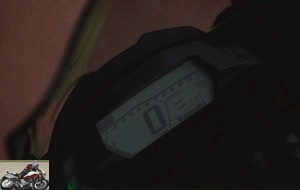
We deeply regret the absence of a gear indicator engaged. A real plus on this type of displacement. No warning or control of the functions on the handlebars ….
In the city
Block 125 comes to life with great discretion, becoming more metallic in the towers. An optional Akrapovic exhaust gives it much more amplitude. You have to accelerate hard enough to get the machines off the ground vigorously. In addition, the pulling of the handle is as long as a day without a motorcycle, a point that I will often note throughout the test..
Riding the roadster, the Z125 takes itself very naturally in Spanish traffic. Particularly agile, its compact size, flat handlebars and sharper geometry work wonders. Lightweight, the two machines are easy to handle, but the Ninja’s bracelets reduce the comfort of the sports car a little. Especially when maneuvering where its higher steering angle (35 ° against 30 °) increases its turning radius (2.90 m, 2.5 m for Z).
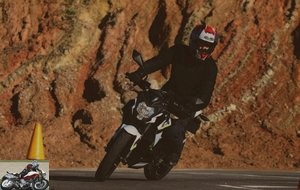
Smooth controls, precise selection and efficient mirrors contribute to Akashi 125’s enjoyment in the city. Maintained beyond 6,000 turns, the block delivers appreciable force on the intermediates. It allows serene evolutions in hyper-urbanized centers without too much knitting of the selector. Rather well staged, the gearbox correctly assists city-dwellers.
Effective between walls, kawettes are also designed to be able to get out. Commuting or more distant journeys, let’s decide between them by cutting the road.
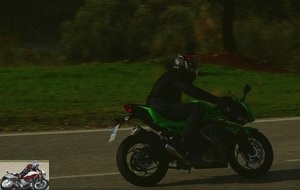
Motorway and expressways
Storming the horizon, the 125 kawa roar their eighth of a liter. The few vibrations of the engine are not very sensitive and the seats provide very good comfort.
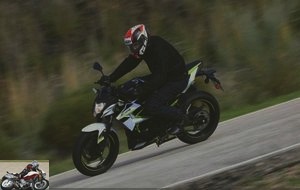
Long journeys are not necessarily better in sport. Bending the legs and wrists more sensitive than on the roadster does not really give an advantage. Admittedly, the protection is less on the Z125, but the limited cruising speeds hardly hamper the approval. Correctly filled at mid-speed, the mono runs out of steam more towards the top of the tachometer, especially on the last report.
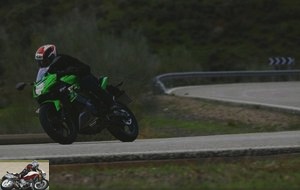
Clearly and as announced by the manufacturer, the mechanics are appreciated under 100 km / h. And since the maximum speed is only 15 units higher and takes some time to reach, the highway will be avoided. What we did not regret on the handlebars of the Z or the Ninja. On these tracks, we reach the limits of these small vehicles whose ergonomics and mechanics are satisfied with shorter journeys at varied pace. Their most obvious playground and that of the secondary network.
Departmental
The funniest aspect of a small displacement is in the handling. On the handlebars, there is no room for mistakes, especially if you are riding with friends. It is indeed necessary to travel fully to maintain speed and avoid cutting the throttle..
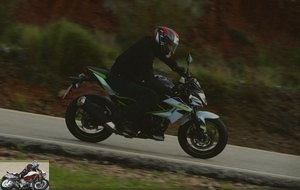
Agile, the Z125 likes to be driven dynamically. Its straight handlebars allow good control and quick changes of direction. However, the liveliness of the front axle with its more closed geometry gives less confidence when the pace really rises. Unlike the Ninja 125 which then gives its best. More stable, offering a position favorable to the attack, it is on his bracelets that I appreciate the arousal more. The long pull of the throttle grip is also easier to manage when downshifting. On the roadster, it is not uncommon to conserve gas or have your wrist too broken to grip the brake lever properly. The sporty Kawa with a pocket size allows all the daring. It’s easy to move from side to side and the machine’s reduced weight makes it a very playful little blade on the road. Hyper reactive, the Kawettes require to be maintained in 7,500 and 10,000 revolutions to benefit from the best of their small mechanics, on the fourth or fifth report.
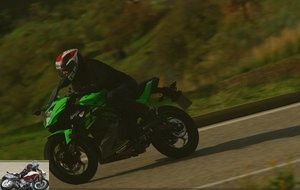
Remarkably well suspended, Z125 and Ninja 125 offer unexpected suspension comfort. If the fork remains flexible when engaging the brakes, the sag management is then well controlled. The two 125s offer very good rigidity, but deserve better tires than the Dunlop TT 900. Offering a correct grip on dry and clean asphalt, they are stingy in feedback and unreliable on the angle when the asphalt is. makes it dirtier or more humid.
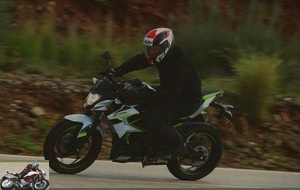
Gymkhana and track
The Kawasaki organization had planned a half-day of handling test in Z125 and a few laps on the track (karting) with Ana Carrasco, world supersport 300 champion, as instructor ….
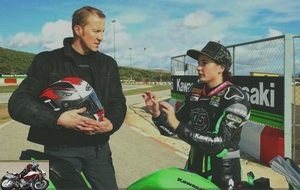
Enough to test the agility of the roadster on a course delimited by series of cones. Once again, Akashi’s frame (to be repeated several times very quickly) demonstrates its quality on this type of exercise. An identical observation on the sports car, precise and lively, but unfortunately served by its tires…. Riding with THE world champion is a rare and appreciable privilege; especially when the latter tells you, during the debriefing, that you are the best pilot of the day…. 😉
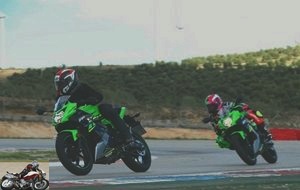
Part-cycle
With their tubular steel frame, the Z125 and Ninja 125 benefit from a hyper-rigid structure with low weight. Combined with good suspensions, the whole delivers appreciable performance, even when driving engaged..

Braking
Powerful, but progressive, the front caliper leaves a lot of control in deceleration. The opposite clamp is also very effective and also dosable to refine an overly optimistic curve passage.
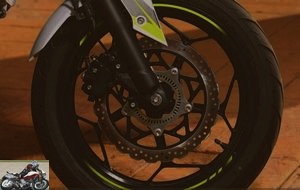
Comfort / Duo
The solo comfort is very correct, both because of the foam of the seats and the quality damping. In the accessories department: saddle cover, chain and radiator protection, 39-liter top case and its support and tank bag. Here you are, set off for the daily adventure.

Consumption
Not measured on this test.
Conclusion
Efficient, such as the Kawasaki Z125 and Ninja 125 seem to me. From the impressive design of the roadster to the efficiency of the sports car’s chassis, Akashi’s small machines are convincing. Their comfort is also a strong point. We regret the slightly timid front of the Ninja and less flattering equipment than the competition (fork, brake). Their mechanics allow good performance, but will have a hard time facing those of sharp contenders. And there are ….!
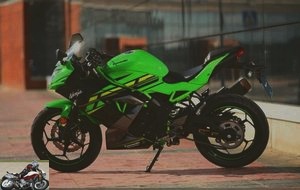
Thus, the Yamaha MT 125 and YZF125 turn out to be true divas with appreciable mechanical characteristics. Priced at 4,999 € and 5,490 €, the tuning forks motorcycles play a high-pitched score. At Honda, the CB125R is a sublime machine, returning 20 kilos to the Z125 and asking for € 4,499. Another Japanese, the Suzuki GSX-R 125 is very efficient and sells for € 4,099. On the European side, KTM Duke 125 and RC125 are priced at € 4,690 and € 4,790 and the superb Aprilia Tuono 125 and RS 125 require € 4,599 and € 4,929.
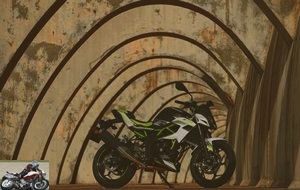
Kawasaki offers its Z125 at € 4,599 and its Ninja 125 at € 4,899 (+ € 100 in two-tone paint for each machine). In a very dynamic market, Akashi motorcycles can count on the overall quality of their construction, quality suspensions and a performance chassis. Clearly, machines to put on your red man list…
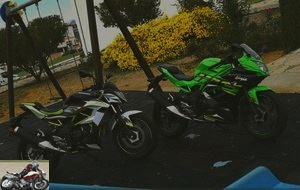
Ninja 125 highlights
- Evidence of handling
- Agility and precision of the chassis
- Ergonomics
- Braking
- Suspensions
Weak points Ninja 125
- Unreliable tires
- Timorous front face
- Long throttle pull
- Equipment too standard (brakes, fork)
- No gear indicator engaged
Z125 strengths
- Powerful style
- Evidence of handling
- Voluntary motor
- Agility and precision of the chassis
- Ergonomics
- Braking
- Suspensions
Weak points Z125
- Unreliable tires
- Long throttle pull
- Equipment too standard (brakes, fork)
- No gear indicator engaged
Kawasaki Ninja 125 technical sheet
Kawasaki Z125 technical sheet
Test conditions
- Itinerary: winding roads with variable surfaces, sometimes wet and dirty.
- Weather: wet and cool to dry
- Motorcycle mileage: 150 km
- Problem encountered: none
Related articles
-
Evolution or revolution of the ER6-f with the in-line twin of 649 cm3, 68 horsepower for 193 kilos A more sporty look but, paradoxically, a gain in…
-
A new little sports car accessible to A2 licenses Twin cylinder in-line, 399 cm3, 45 hp at 10,000 rpm, 38 Nm at 8,000 rpm, 168 kilos, from € 5,999…
-
Kawasaki Ninja ZX-10R KRT motorcycle test
An integer character 4 cylinders in line, 998 cm3, 203 hp, 114.9 Nm, 206 kg all full facts, 18,099 euros. Nice surprise for me to find the Kawasaki…
-
Ninja Apprentice On paper, we imagine that the Kawasaki Ninja 250 R, with only 33 horsepower, will only appeal to the young drivers. After a week of…
-
Comparison test Triumph Tiger 900 GT Pro and Rally Pro
Annexation of new territories 3 cylinders in line, 888 cm3, 95.2 hp, 87 Nm, 198 kg and 201 kg, euros Although the creative nation of rugby, the English…
-
BMW R1200RS comparison test – Kawazaki Z1000SX
Travelers with character Traveling on a motorcycle does not rhyme exclusively with large GTs, efficient but cumbersome, or maxi-Trails, useful but too…
-
Kawasaki Ninja 1000 SX motorcycle test
Compromise without compromise 4 cylinders of 1,043 cm3, 142 hp and 111 Nm, 235 kg, from 14,349 euros In 2010, Kawasaki presented its first Z1000SX, a…
-
Sporty for big cube bikers The Kawasaki 300 Ninja succeeded the 250 Ninja in 2013. While the 250 was a nice little bike, the 300 underwent a bodybuilding…
-
BMW F 900 R and F 900 XR comparison test
The evolutions of the 850 with the look of the 1000XR sport trail and the R1250R roadster Inline twin, 895 cm3, 105 hp, 92 Nm, Euro5, 211 and 219 kg BMW…
-
Rock’n roll attitude ! Sitting less than 70 cm from the ground, feet propped far forward and holding the wide handlebars of the VN 900, I taste the…
Completely agree with you: the virtual absence of safe, it really sucks. And even more damaging than the rest, this XCiting S400i is a hit in all other areas !
thank you for following us,
Philippe
yop! corn…
it would take several edits to do them all..
All 125 of the market, by categories, in several editorials, it’s an idea.

Good luck for the organizer but nice idea.
With something like "the 24 hours of the 125", the kind of thing MJ was doing a long time ago.
Consumption on the motorway at legal speed seems wrong to me.
A Tmax under the same content conditions of 5L5.
This nice scooter is still at a fairly high price but justified with regard to the competition. The five-year warranty is an important argument, but there is a deal breaker; the trunk which is much too small. Designers need to use a scooter on a daily basis to realize the usefulness and convenience of a large trunk. There is always the top box parade, a sort of backpack that is particularly dangerous in the event of a fall. Also on an aesthetic level, I find that these suitcases break the line of the two wheels.